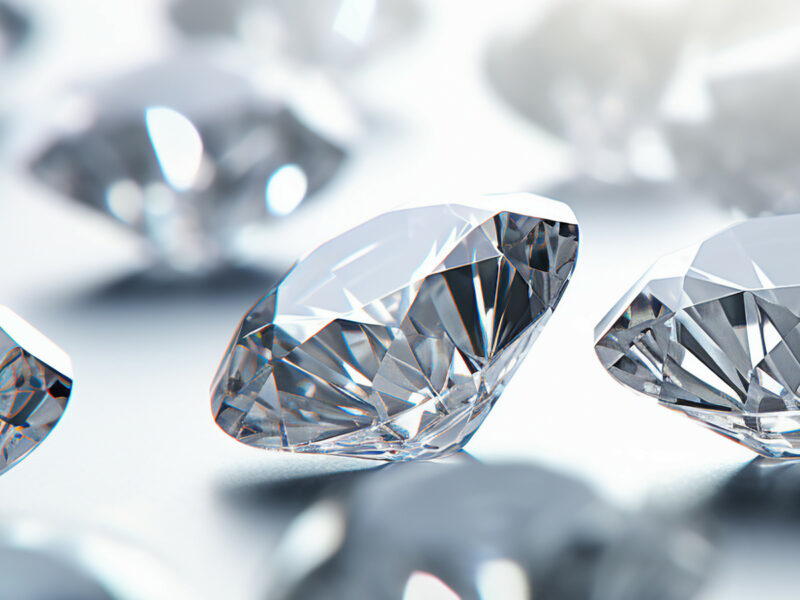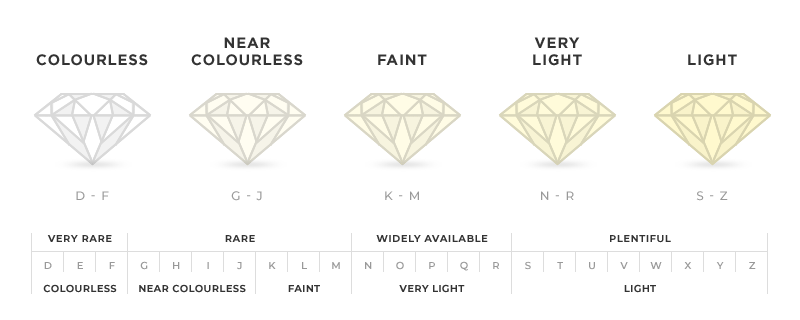
Featured Brand: Patek Philippe
Iconic Advertising Reinforces Patek Philippe Heritage
A luxury watch costs thousands, millions even for the rarest and unique pieces. With …
Read more
Buying a diamond can feel like a big deal, and honestly, it is! But, having some savvy is required: It’s not just sparkle that counts.
You’ve likely come across the 4 Cs of Diamonds – Cut, Carat, Clarity, and Colour – the factors that determine a diamond’s value. Among these, colour is a subtle yet crucial detail that influences a diamond’s beauty and price.
If you’re looking for a dazzling piece of diamond jewellery and feel uncertain about selecting the best colour, fret not! Our detailed guide will reveal everything.
When you think of diamonds, you might picture a sparkling, clear gem. While that’s the ideal image, true colourless diamonds – or those that appear white at first glance – are quite rare. Most have subtle shades of yellow or brown, almost imperceptible unless you really know what you’re looking for.
This is where the Gemological Institute of America (GIA), steps in. They’re the authority in diamond quality, setting the standard with a grading system that evaluates colour from D (absolutely colourless) to Z (noticeable yellow or brown tint).
You might also hear about the diamond colour “hue,” “tone,” and “saturation.” Hue refers to the actual shade of the diamond. Tone, on the other hand, considers the colours’ lightness or darkness, while saturation refers to colour intensity.
The GIA diamond colour grading scale was established in the early 1950s and is the go-to standard for professionals across the globe.

On the GIA diamond colour chart, there are 23 unique colour grades. These are further grouped into five clear categories:
| Colourless (D-F) | D to F diamonds are the top tier, with no colour you can see. D is the pinnacle of purity, with absolutely no colour, while E and F have such tiny traces that only experts can tell. These are hard to come by, especially large ones, making them more expensive. |
|---|---|
| Near colourless (G-J) | G diamonds have just a whisper of colour, almost impossible to see. H and I diamonds show a bit more, and you might spot a faint yellow in J diamonds under bright lights, but they’re still pretty clear. |
| Faint yellow (K-M) | K diamonds start showing more colour, which you can see with the naked eye. L and M diamonds have a clearer yellow look that everyone can notice. These diamonds, especially M diamonds, are often set in yellow or rose gold jewellery to make the colour look intentional rather than like a flaw. |
| Very light yellow (N-R) | N to R diamonds have a light colour, are easy to spot, and they’re not common in fancy jewellery like engagement rings. They’re often referred to as ‘Champagne diamonds’ for their distinct look. |
| Light yellow (S-Z) | These are considered the strongest in terms of colour, and can be either light yellow or brown diamonds. You won’t typically find them in regular jewellery stores. |
The term “best” can be subjective, especially when discussing diamond colours. However, a “D” colour holds the highest colour grade and is therefore considered the best diamond colour. These diamonds are a rarity and aren’t what you’d typically come across in most jewellery stores. According to the GIA’s standards, a D-colour diamond is the epitome of perfection in terms of colour, or rather, the lack of it.
The GIA Diamond Color Scale begins with the letter “D” for a very intentional reason: the founders wanted a clean break from the older systems that were in use at the time. These earlier methods often used “A” or “AA” grades, but these could be ambiguous and inconsistent. There was also the American Gem Society (AGS) employing its own numerical system, but this was exclusive to AGS members.
“Fancy coloured diamonds” are essentially diamonds that come in an array of colours or “hues”, tones, and saturations. Think red, green, purple, orange, pink, and blue.
These fancy-coloured diamonds are incredibly rare and expensive. Their value comes from three factors: the main colour (or hue), how dark or light it is (tone), and how strong the colour appears (saturation).

Some diamonds appear more coloured than others, even with the same colour grade. This difference is often due to two factors: size and shape.
Larger diamonds tend to show more colour, so for diamonds over 1 carat, a G-H colour grade is often preferred. For those under 1 carat, an I-H grade is ideal, as any colour present is harder to detect in smaller stones.
The shape also plays a role. Diamond shapes with more facets, like round or princess, reflect more light, masking colour better. In contrast, shapes with larger facets, such as emerald or Asscher, can reveal more of the diamond’s colour.
Diamond colour greatly influences its market value. Put simply, the less colour, the higher the worth, particularly for colourless (D-F) diamonds. Even the slightest difference in colour has an impact on the price.
White diamonds with a ‘D’ colour grade are the rarest due to their unique formation conditions that result in no colour. People want what’s hard to find, which ups the value.
On the other hand, fancy-coloured diamonds, which fall outside the D-Z range, are also highly valued for their rich, vibrant hues.
Picking the perfect diamond colour can be tricky, but it’s all about finding a balance between what catches your eye and fits your budget.
Here at Global Boutique, we pride ourselves on offering diamonds in the F-G colour range – a great blend of quality and cost.

Grading a diamond’s colour is a precise art. Experts use a set of reference diamonds and controlled lighting to make this call. This meticulous process, performed with the diamond loose (not set), requires a keen eye and deep expertise.
Now, when you’re out diamond shopping, assessing diamond colour can be trickier.
Here are some practical tips to assess a diamond’s colour:
Remember, various lighting conditions can drastically alter a diamond’s appearance. That’s why we recommend visiting our brick-and-mortar store in Mayfair, where you can truly understand what you’re buying.
Yes, the setting can affect how a diamond’s colour looks. Diamonds with a bit of colour (I-K range) shine best in yellow-gold settings, making them appear whiter. Colourless diamonds stand out in platinum or white gold settings, highlighting their clear quality.
Diamonds get their colour from tiny bits of chemicals or changes in pressure deep in the Earth where they form. Even small amounts of other elements or changes in the environment can give diamonds their unique colours.
While we all love the icy allure of a colourless stone, diamonds across the spectrum have their own kind of magic. It’s all about finding the gem that speaks to you.
Look at diamonds under different lights, from various angles, and see how they speak to you. After all, you’ll be the one admiring that beautiful sparkle every day!
Explore our collection of dazzling diamond jewellery and feel free to reach out with any queries.

Featured Brand: Patek Philippe
A luxury watch costs thousands, millions even for the rarest and unique pieces. With …
Read more
Featured Brand: Hermès
If you're a fan of luxury handbags, the Hermès Constance is likely on your radar …
Read more
Featured Brand: Hermès
Described as practical, stylish, and highly desirable, the Hermès Birkin bag has …
Read more
Featured Brand: Rolex
Watches and Wonders 2025 has been a landmark event for horology enthusiasts, with …
Read moreMayfair’s finest collectable jewellery and watch retailer - Book an appointment
Shop
About Global Boutique
Global Boutique
13 South Molton Street,
Mayfair, London, W1K 5QW,
United Kingdom
Telephone:
0800 069 9323
Email:
enquiries@globalboutique.com
Sign up for our newsletter
Receive exclusive news from Global Boutique, including product releases and updates
© 2026 Global Mayfair Boutique Ltd - all rights reserved
Registered Office: 27 Mortimer Street, London, W1T 3BL, United Kingdom.
Registered in England and Wales, Company number 13680049. Registered VAT Number GB 396600769.
We’ll share helpful and informative information about watches and more from the luxury world, as well as our newest arrivals, and special events.
* We promise not to overload your inbox, and to never sell or share your information. Unsubscribing is easy.
